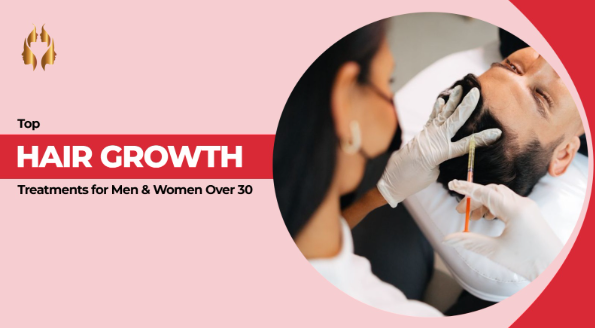Blog Details
Home > Blog> Blog Details

Successful Surgeries
Doctors
Happy Patients
If you got any questions, please do not hesitate to send us a message. We reply within 24 hours.
Top Hair Growth Treatments for Men & Women Over 30
After the age of 30, hair loss is on the increase because of genetic inclination, hormonal changes, and lifestyle changes. Sadly, a number of scientifically supported therapies are able to delay shedding and induce regrowth.
Minoxidil (Topical and Oral)
Minoxidil is a potassium-channel opener which increases the blood circulation to the scalp and prolongs the anagen phase. It can be used on the male and female body, approved by the FDA in 2% and 5% of liquid or foam. The regrowth of hair is expected to appear after 3-6 months of constant use, and the maximum effect is observed after 12 months. Research indicates that the density of hair grows by 10-30 percent and hair thickness also rises by 10-25 percent. The 5 per cent solution works better than the 2 per cent, but it is preferable that women use the lower concentration to reduce the side effects. Scalp irritation and undesired facial/body hair are among the common side effects. Oral minoxidil (0.255 mg/day) at low doses is becoming an option; preliminary studies indicate an improved adherence, but it has low blood pressure and swelling as its common side effects.
5alpha-Reductase Inhibitors ( Finasteride and Dutasteride)
Finasteride and dutasteride inhibit testosterone to dihydrotestosterone (DHT) gene that causes follicle miniaturisation. The FDA-approved hormone is finasteride (1 mg/day) in the therapy of male androgenetic alopecia, which enhances hair density by 10-20 percent in 1 year. More than 80 per cent of men retain the hair that they have more than five years and some studies point out that the use of finasteride combined with minoxidil has a better effect. The side effects are decreased libido and erectile dysfunction, dutasteride has a greater potential side effects but is more potent. Child bearing-aged women should not take these drugs as they are likely to produce birth defects.
Low‑Level Laser Therapy (LLLT)
LLLT involves the utilization of red or near-infrared light to enhance cellular activities, extend anagenesis and enhance hair growth. An evidence based review on 15 studies identified that LLLT promotes the growth of hair in both men and women with androgenetic alopecia, and randomized controlled trials showed a significant growth in terminal hair counts. It is a non-invasive therapy, approved by FDA and can be done at home using laser caps or combs. A study demonstrated that the effectiveness of LLLT was equivalent to topical minoxidil and the combination of the two modalities was even more effective. Although evidence continues to change, LLLT is a promising alternative to those individuals who are not tolerant of medications.
Platelet-Rich Fibrin (PRPF) and Platelet-Rich Plasma (PRP).
PRP is a technique that entails the injection of concentrated platelets of a patient to the scalp to provide growth factors. Recent reviews point out that application is crucial to success, with microneedling delivery generating more hairs and greater hair density than point-by-point injections. Platelet-rich fibrin (PRPF), a more advanced formulation with higher concentrations of growth factors, led to a much higher hair density and terminal hair growth than the conventional PRP. PRP or PRPF used together with interventions such as minoxidil or microneedling is more effective and very satisfying to the patients. However, the protocols differ, and several sessions (typically three to six separated by two to four weeks) are required to maintain long-term outcomes.
Hair Transplantation (FUE)
In advanced cases of hair loss surgery can be used as an irreversible means of hair replacement. The follicular unit extraction (FUE) is a method that entails the acquisition of the single follicular units of a donor site and then placing it in balding regions. A 2024 study of 158 patients reported a survival rate of over 90 percent of transplanted follicles; more than 85 percent of the patients had a survival rate over 95 percent at twelve months after the operation. The satisfaction rates of the patients were more than 98 % and in less than 6 % of the situations the complications were reported. FUE is very small-scale, and it has a little scar, and it gives natural density. The recovery period is approximately one week and the final outcome can be observed after 9-12 months.
Emerging Treatments
JAK inhibitors: These are oral medications that inhibit inflammatory mechanisms that cause alopecia areata. Ruxolitinib and baricitinib are new agents that have led to 50 percent or more scalp hair regrowth in 6570 percent of trial subjects.
Stem cell and gene-based therapies: Studies of stem cell-produced exosomes, Wnt activators and gene editing are seeking to repair follicles, however such intervention is still under investigation.
Nutritional Support and Lifestyle.
Drug use is not the whole solution. Hair can be grown on a balanced diet which contains a lot of iron, zinc, vitamin D and protein. It is also essential to manage stress, sleep well and do not use tight hairstyles (to avoid traction alopecia). Individuals above 30 years are expected to visit a dermatologist to eliminate the possibility of other underlying factors like thyroid malfunction or hormonal disorientations.
Final Thoughts
The best option in the treatment of hair-loss is determined by your tolerance to drugs, surgery and affordability of the treatment as well as the cause. Topical minoxidil is the initial treatment to use in men and women with an exception of finasteride; which is also appropriate when used by men who can tolerate them. Other methods such as LLLT and PRP are non-invasive and surgical FUE transplantation can be used as a permanent remedy to severe cases of hair loss. The synergies between therapies are usually the most effective and prompt treatment is the most important to maintain and repair your hair.
Copyright reserved @ 2023 Raj Cosmetic & Plastic Surgery Centre